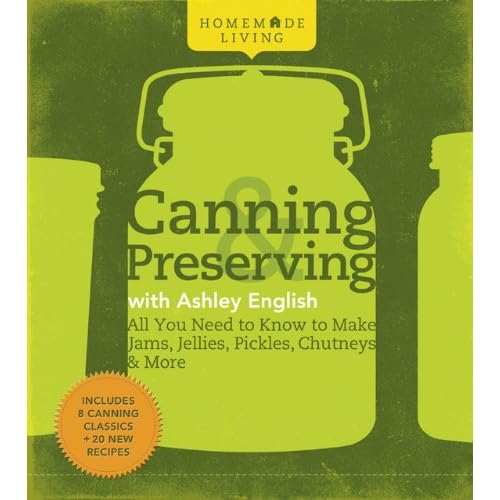There was something that captured my fascination back then when I'd run my finger along the light film of dust that had gathered on the rows of glass containers in their basement. And now that I'm older, and dreaming of my own someday-garden, the desire to pick up that pastime of canning has only grown.
Which is why when I came across Canning and Preserving by Ashley English
Her book is a primer on canning, offering an overview of the science behind the process, a list of all the essentials you'll need to get started, a handy reference guide to which fruits and vegetable varieties are best suited to canning, trouble-shooting any difficulties that might crop up, in addition to all the how-to's of canning itself, which are thoroughly illustrated step-by-step through instructional diagrams and photographs.
There are recipes and complete instructions for making jams, jellies, relishes, pickles, marmalades, chutneys, butter, sauces as well as preserving whole fruits and vegetables—basically whatever you might dream of that will fit into a glass jar.
I have not gotten to make any of the recipes just yet—I don't want to waste my effort on store-bought produce—but have pages earmarked that walk you through making strawberry jam, apple butter, and tomato basil sauce (although I'll need a pressure canner for that one). Those are some pretty basic recipes, but there are also more exotic ones like Fig and Thyme Jam, Curried Winter Squash Chutney, or Peach and Lavender Butter.
I think that if you're just starting out with canning and preserving, like I am, this is a great resource. However, it's not an exhaustive guide if you're looking for tons of recipes: In total, there are 28 recipes provided, which cover 8 canning classics and then 20 unique seasonal recipes (like the examples listed above). Personally, I wish there were more of the "canning classics" recipes included, but I guess they figured that you can look those up easily anywhere?
Regardless, I look forward to the day when I can line my own pantry shelves with little glass jars that suspend summer for just a little bit longer...
Find Canning & Preserving by Ashley English on Amazon.com.
Related Posts
The Homesteader's Kitchen Cookbook Review
Dreaming of My Someday-Garden






All your posts are so cohesive
ReplyDeletemakes for easy reading.
@ Tamara: Aw, thanks so much! :) That means a lot!
ReplyDeleteI have ALWAYS wanted to learn the art of canning & preserving. Unfortunately, since I would be the first in my family to do this, I don't have anyone to learn from. Thank you for sharing this guide! I'll have to add it to my list!
ReplyDeleteBlessings,
Heather
Well maybe you could get what you are looking for at :
ReplyDeletehttp://www.bbcgoodfood.com/content/recipes/favourites/pickles-jams-and-chutneys/
For beginners, I recommend starting with apricot jam. It is easy and tasty !
Oh I love canning! My mom would grow a garden and make salsa and can it and she would also make jams and jellies. They are so good! I read in the june issue of Martha Stewart Living and this one lady was saying that she cans a little at a time. She would make a bigger batch of tomato sauce and then can a couple cans every time she cooked. I thought that was kinda a good idea. I will do that once I get my own place. I always love your posts.
ReplyDeleteI understand that you don't want to can expensive store bought produce. Until very recently I had a childcare and not enough room to grow a vegetable garden, but here are the things that I can on a regular basis. I take the left over parts from cutting up chickens add water,onion,carrot,celery and a little seasoning and make chicken stock in my 22 quart roaster. For smaller amounts you could use a crock pot. I then can the chicken stock. It is much healthier and cheaper than store bought and much easier to use from a jar rather than frozen. I also can my own pinto beans, they get cooked in the jar as they can. For convenience and taste I can my own pasta sauce with meat. I also make my own BBQ sauce sweetened with stevia(my husband is a diabetic). Someone recently gave my daughter about 20 lbs of potatoes that we could not use up before they would go bad. Did you know that you can can potatoes? They come out perfect for making potato salad or home fries. You could even reheat them and make mashed potatoes. I am sure there are other things that it would make sense to can, even if you don't have a vegetable garden.
ReplyDelete